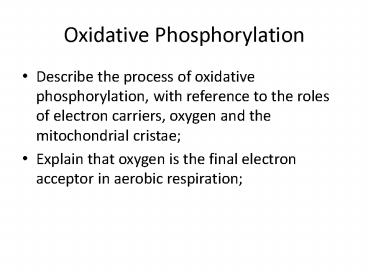Oxidative Phosphorylation - PowerPoint PPT Presentation
Title:
Oxidative Phosphorylation
Description:
Oxidative Phosphorylation Describe the process of oxidative phosphorylation, with reference to the roles of electron carriers, oxygen and the mitochondrial cristae; – PowerPoint PPT presentation
Number of Views:56
Avg rating:3.0/5.0
Title: Oxidative Phosphorylation
1
Oxidative Phosphorylation
- Describe the process of oxidative
phosphorylation, with reference to the roles of
electron carriers, oxygen and the mitochondrial
cristae - Explain that oxygen is the final electron
acceptor in aerobic respiration
2
Oxidative Phosphorylation happens via the
electron transport chain
- All the products from the previous stages are
used in this final stage. Its purpose is to
transfer the energy from molecules made in
glycolysis, the link reaction and the Krebs
cycle to ADP. This forms ATP, which can then
deliver the energy to parts of the cell that need
it. The synthesis of ATP as a result of the
energy released by the electron transport chain
is called oxidative phosphorylation - The electron transport chain is where most of the
ATP from respiration is produced. In the whole
process of aerobic respiration, 32 ATP molecules
are produced from one molecule of glucose 2 ATP
in glycolysis, 2 ATP in the Krebs cycle and 28
ATP in the electron transport chain - The electron transport chain also reoxidises NAD
and FAD so they can be reused in previous steps
3
Respiration The 4 Parts
- Respiration consists of 4 parts
- Glycolysis
- Link Reaction
- Krebs Cycle
- Oxidative Phosphorylation (the electron transport
chain)
4
Oxidative Phosphorylation produces lots of ATP
- The energy needed for ATP synthesis is provided
by the electron transport chain. It uses the
reduced NAD and FAD from the previous 3 stages to
produce 28 molecules of ATP for every molecule of
glucose
5
Whats going on?
- It involves electron carriers embedded in the
inner mitochondrial membranes - They are folded into cristae which increases the
surface area (providing more electron carriers) - The electrons are passed along a chain of
electron carriers and then donated to oxygen the
final hydrogen acceptor
6
Whats the point?
- As electrons flow along the electron transport
chain, energy is released and used by coenzymes
associated with proteins 1, 3 and 4 to pump
protons across the intermembrane space - This builds up a proton gradient which is also a
pH gradient (lowers the pH) and an
electrochemical gradient - The hydrogens can only get back through the ion
channel which is associated with ATP synthase - The flow of hydrogen ions through this ion
channel is called chemiosmosis
7
H
Outer membrane of mitochondrion
H
H
H
H
H
H
Intermembrane space
Stalked particle
Inner membrane of mitochondrion
ATPsynthase
Carrier 2
Carrier 3
Carrier 4
Carrier 1
2e-
ADP Pi
2e-
H
H
2H
H
NADH H
2H2O
ATP
2H
H
NAD
O2 2H
Matrix of mitochondrion
8
Oxidative Phosphorylation produces lots of ATP
- 1. Hydrogen atoms are released from NADH H and
FADH2 (as they are oxidised to NAD and FAD). The
H atoms split to produce protons (H) and
electrons (e-) for the chain. - The electrons move along the electron chain (made
up of three electron carriers) losing energy at
each level. This energy is used to pump the
protons (H) into the space between the inner and
outer mitochondrial membranes (the intermembrane
space)
9
Oxidative Phosphorylation produces lots of ATP
- The concentration of protons is higher in the
intermembrane space than in the mitochondrial
matrix, so an electrochemical gradient exists. - The protons then move back through the inner
membrane down the electrochemical gradient,
through specific channels on the stalked
particles of the cristae- this drives the enzyme
ATP synthase. By spinning like a motor, this
enzyme supplies electrical potential energy to
make ATP from ADP and inorganic phosphate - The protons and electrons recombine to form
hydrogen, and this combines with molecular oxygen
(from the blood) at the end of the transport
chain to form water. Oxygen is said to be the
final electron acceptor
10
The Importance of Oxygen
- We have learned that oxygen is the final hydrogen
acceptor in respiration - We are now gong to look at the uptake of oxygen
by respiring organisms
11
(No Transcript)
12
(No Transcript)
13
(No Transcript)
14
(No Transcript)
15
Plenary
- Complete the missing word sheet































